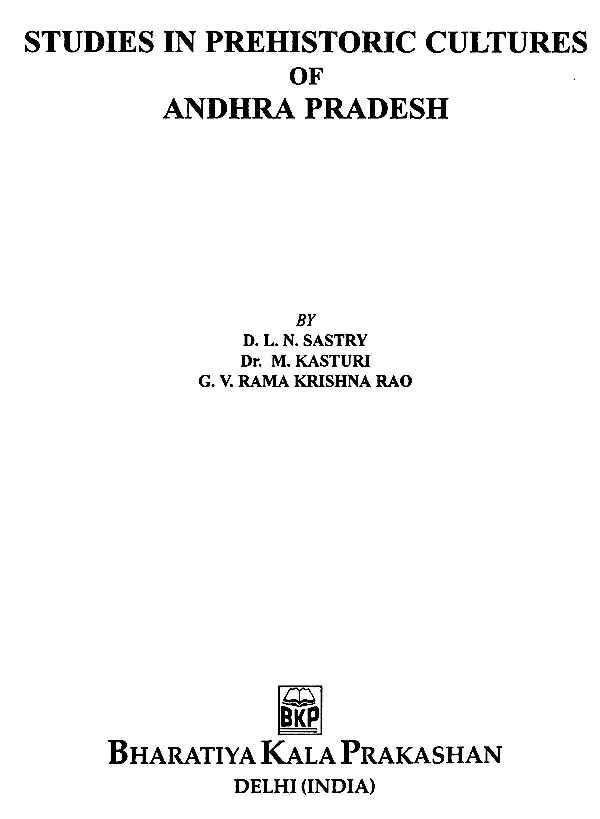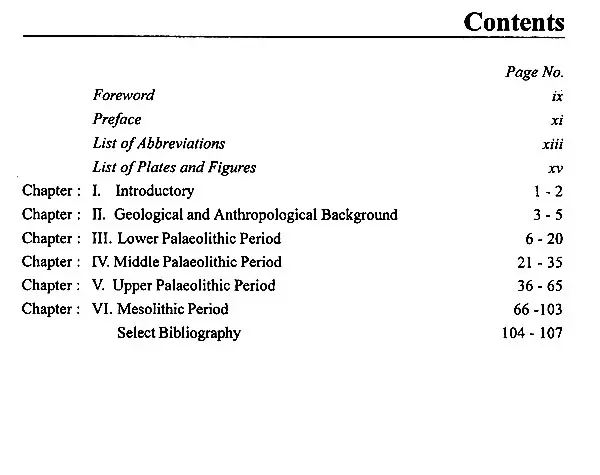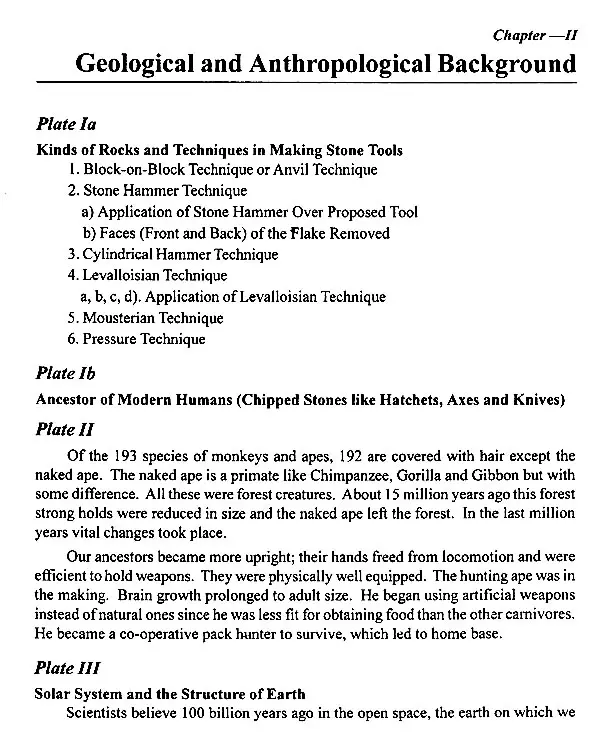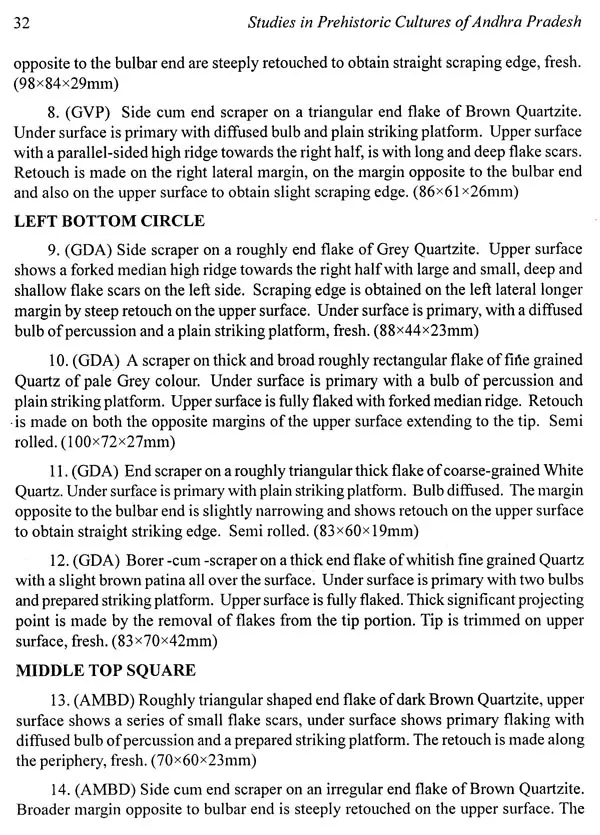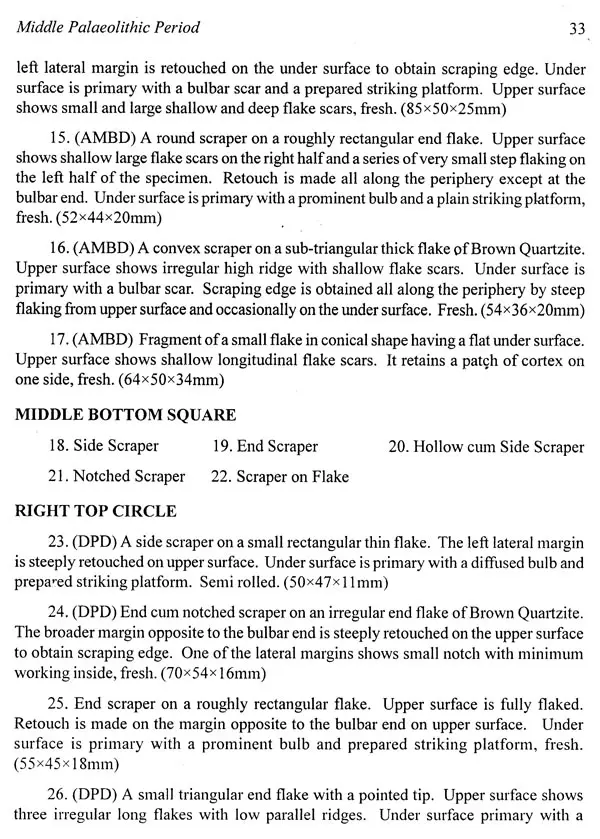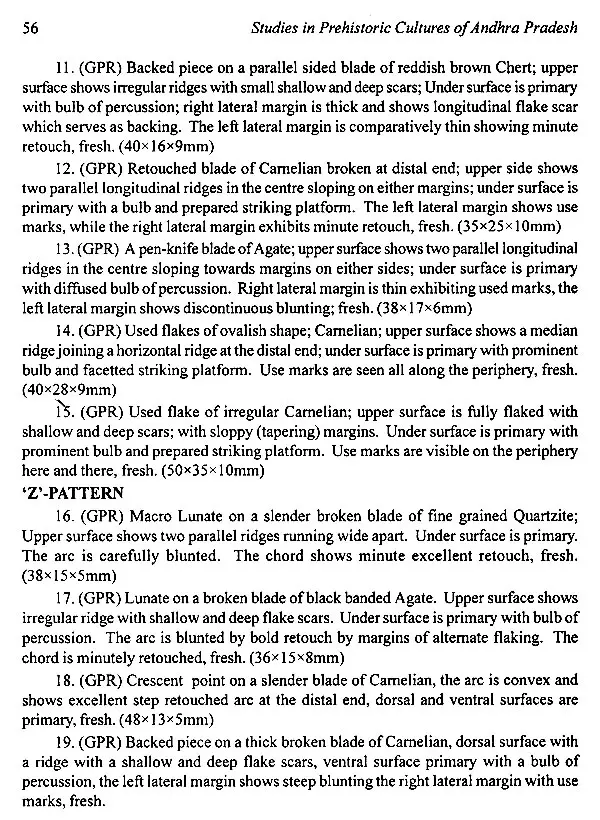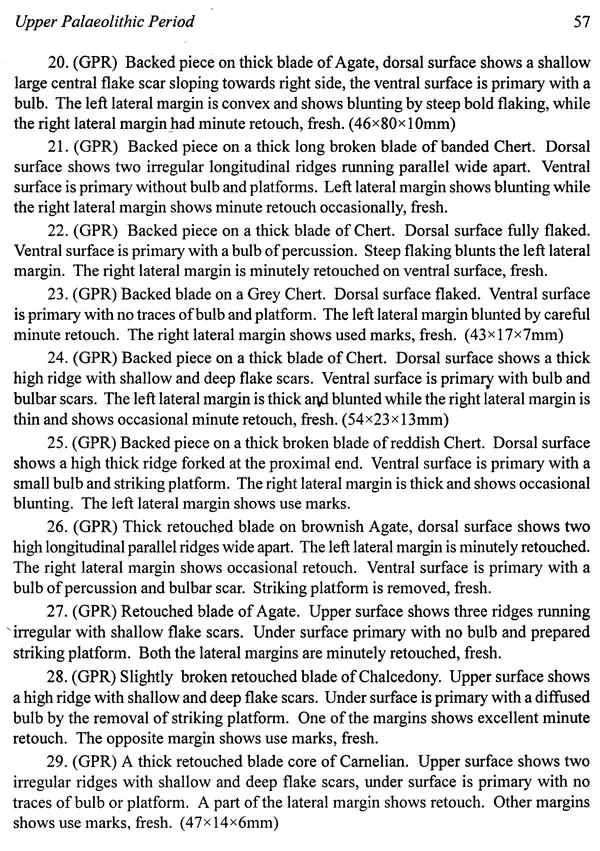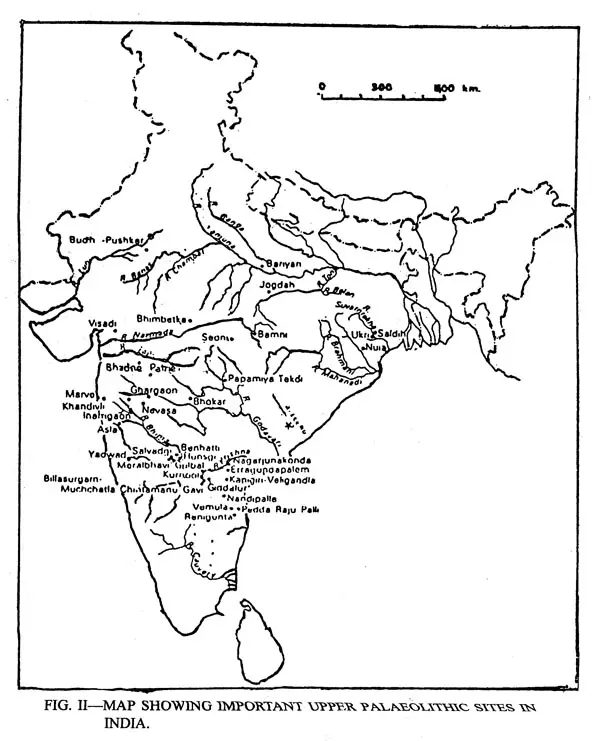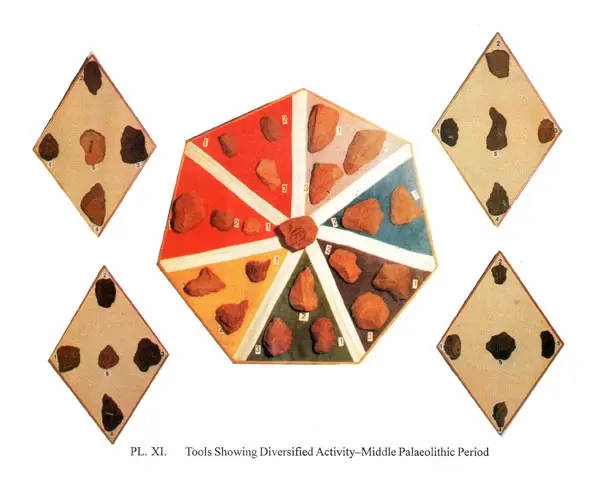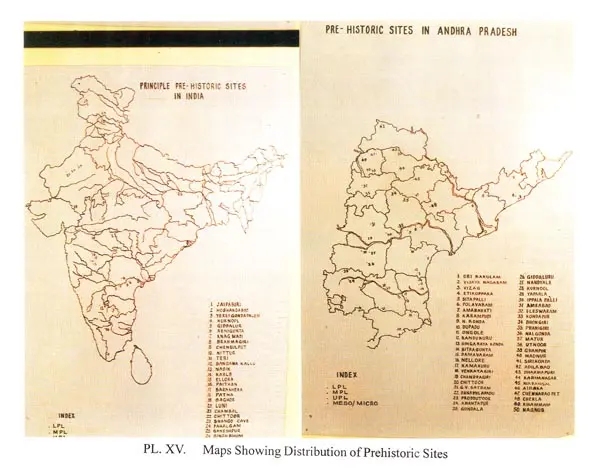
Studies in Prehistoric Cultures of Andhra Pradesh
Book Specification
| Item Code: | UAO053 |
| Author: | D. L. N. SASTRY & M. KASTURI & G. V. RAMA KRISHNA RAO |
| Publisher: | Bharatiya Kala Prakashan |
| Language: | English |
| Edition: | 1999 |
| ISBN: | 81860550388 |
| Pages: | 140 (Throughout Color Illustrations) |
| Cover: | HARDCOVER |
| Other Details | 10.00 X 7.50 inch |
| Weight | 500 gm |
Book Description
The material selected from various sites by the department and displayed in the Plates (showcases of the Museum). forms the source material for this work, "Studies in Prehistoric Cultures of Andhra Pradesh".
Brief information on the researchers made and interpretations given in the Lower, Middle, Upper and Microlithic Periods by scholars in the field is also recorded for a clear understanding.
Fundamental information in Earth Science, Life History and Anthropology is provided in Plates as background knowledge in brief. For a better understanding of tools, a detailed note on each artifact in Plates is also given in this work.
Mr. D.L.N. Sastry was born in the year 1941 at Mogalikuduru, a village adjacent to Razole in East Godavari District. He had his school education at Malikipuram and Manepalli and took his M.A., degree in Ancient History and Archaeology from Osmania University under Professors Dr. R. Subrahmanyam and Dr. R. Narasimha Rao in the year 1969. He did his M.Phil on "Prehistoric Cultures of the Manjra Valley" under the guidance of Dr. B.R. Subrahmanyam, Professor, in Ancient History and Archaeology, Nagarjuna University, Guntur in the year 1985.
Mr. Sastry joined the Department of Archaeology and Museums in the year 1970 as Technical Assistant and worked at Hyderabad, Vijayawada and Warangal.
He was promoted in the year 1981 and in that capacity he worked at Tirupathi, Vijayawada, Warangal and Hyderabad holding the posts of Assistant Director excavations and Assistant Director regional.
At present, he is working as Assistant Director, Srisailam project. At Somasila village, fourteen temples (datable to 14 16c. A.D.) Were conserved in the sub mergence area. Presently he is atten ding to the reconstruction work of Panchayatana group of Shrines at Ramateertham in Mehaboobnagar District.
A book titled "The Prehistoric Cultures of the Manjra Valley" was published by him in 1997 and the book on "The Excavations at Paidigutta" a Protohistoric site was sent to press in the month of September 1998 and the book on, "The Excavations at Nelakonda palli" in Khammam District of Andhra Pradesh is in preparation.
General survey on Stone age evidences has been carried out by the State Department of Archaeology and Museums, Andhra Pradesh, Hyderabad since 1960, and discovered a good number of artifacts from various sites in Andhra Pradesh. Organization of Prehistoric Gallery in Sri Sailam Pavilion, a Museum in the premises of the Directorate of Archaeology during the year, 1998 brought to public the said discoveries, however, they remained unpublished. The material selected from various sites by the department and displayed in the Plates (showcases of the Museum), forms the source material for this work, "Studies in Prehistoric Cultures of Andhra Pradesh".
Fundamental information in Earth Science, Life History and Anthropology is provided in Plates as background knowledge in brief. For a better understanding of tools, a detailed note on each artifact in Plates is also given. Some more description is provided on tools though not covered by Plates for type-sites of the Microlithic period such as Ghanpoor, Sitapalli and Chennaraopet. The aim behind this is to enable interested students to make out different pointed, edge and multipurpose tools in the assemblages of different periods of the Palaeolithic and Microlithic. Also, to get information about the nature and stage of manufacture, raw material selected, techniques applied, probable function a tool served in a given economy and the progress made. Self-explanation in Plates may enable independent study.
Brief information on the researchers made and interpretations given in the Lower, Middle, Upper and Microlithic Periods by scholars in the field is also recorded for a clear understanding.
First, I wish to express my appreciation to my colleague, Dr. M. Kasturi who extended so much co-operation in the preparation of Plates and Manuscript. Also my appreciation to Sri Ramakrishna, Technical Assistant, who associated with us in the entire work sincerely.
I am thankful to Sri N. R. V. Prasad, former Director, Department of Archaeology and Museums, Government of Andhra Pradesh, Hyderabad, for initiating me to this work.
My sincere thanks are due to Sri S. Dasarathi Chief Museum Officer, Department of Archaeology and Museums, Government of Andhra Pradesh, Hyderabad, for his expert guidance in the arrangement of Plates.
The present work "Studies in pre-historic Culture of Andhra Pradesh" by Shri D.L.N. Sastry is aimed at providing logical and reasonable awareness of Earth's past and the history of human life, besides a brief description of the various stages in the evolution of Man. According to Sir James Jeans, the entire solar system is as small as a particle in the total area of the universe and the knowledge so far attained is relative and limited. It is just like the extent of the brightness of a torch in an extensive area in darkness. However, from the historical facts, it is evident that philosophers like Confucius, Buddha, Lovotes, Socrates etc. tried to understand nature around us and the role of man during 2800-1600 years before present. However the scientific inquiry has been going on since Bacon during the last 300 years. Palacolithic and post-Palaeolithic evidences in India began appearing from the last part of the 19th century. With the aid of these discoveries, the pre-historians began studying spacio-temporal aspects of stratigraphy and techno-temporal aspects with the inter-disciplinary approach for probing into the life ways of pre-historic people.
The author has successfully provided basic archaeological data fot the various evolutionary phases of Man in Andhra during the Lower, Middle, Upper and Microlithic periods of the palaeolithic age supported by illustrations. He has also classified the unpublished artefacts collected from various parts of the State since 1960 by the department.
The book also makes simple reading to understand and identify the varied tool types, the raw materials used, probable function of a tool in a given economy and the advances made in tool making techniques. The discoveries made and interpretations given for each sub period by eminent research scholars in the field are also recorded. This enables interested students in the field to take up independent study.
The author, Shri D.L.N. Sastry with his deep knowledge of pre-history rendered yeomen services in high lighting the Stone Age culture of Andhra-desa. A glance through the book reveals the pains the author has taken to bring out a work of this nature. Being a senior officer in the Department of Archaeology and Museums, with vast experience in the field of Ancient Indian History, Culture and Archaeology and scholarly background his work provides fascinating study in pre-historic archaeology. I have no doubt that this work will receive the attention of the scholarly world, students and the public at large.
About two million years ago climate and topological changes led to a series of great continental glaciers covering large areas of northern hemisphere with a thick sheet of ice. These two million years of expanding and contracting continental ice sheets in four spells are the Pleistocene epoch. During this epoch, there were fluctuations of the present sea level, ranging from a maximum of 200 mts, and to a minimum of 150 mts. As a result large areas of the continents were submerged and exposed. The principle effect of the advancing and receding ice-sheets (glaciers) has been to cause rapid changes of distribution in animal and plant species. Extreme climatic changes of the Pleistocene time appear to have led to relatively little extinction of animals and plants. A large number of land mammals such as Mammoths, Mastodons, Ground Sloths and Sabre Tooth Cats became extinct in Late Pleistocene time.
Scientists basing on the evidences of fossils - the remains of ancient animals and plants, could study the kind of life existed and the changing environment of the past. They believe that the history of life is two billion years old and it is closely linked with earth sciences, which is four or five billion years old. Fortunately during the Pleistocene period in the history of life, they could observe the evolutionary sequence of man more clearly than his ancestor's in the Pre-Pleistocene period. The oldest Pleistocene men are now assigned to Genus Australopithecus. The Australopithecines were succeeded in the middle Pleistocene time, by large brained species Homo erectus i.e. so like modern man.
Man with his physical organism, is subjected to natural laws as other animals. But he is a unique social organism. Similar to bee society individuals carries out their life roles with instinctive and without coaching from their parents are other elders. For man, however, most behaviors are leamed. Again man's uniqueness lies in his capacity for culture the potential bom of complex mental development, unsurpassed in the animal kingdom. It enables man to manipulate the environment to suit his own desires and comforts. Scientists are concerned with the origin and development of man's culture. In this connection it is to be remembered that the oldest fragments of written human history go back only to 5000 years while the Prehistoric human record is two million years old. Man (like Australopithecus/Homo erectus) used stone tools principally large hand-axes made from pebbles. These tools show a progressive advance in design and workman ship through middle Pleistocene times. Like Australopithecus, Homo erectus
